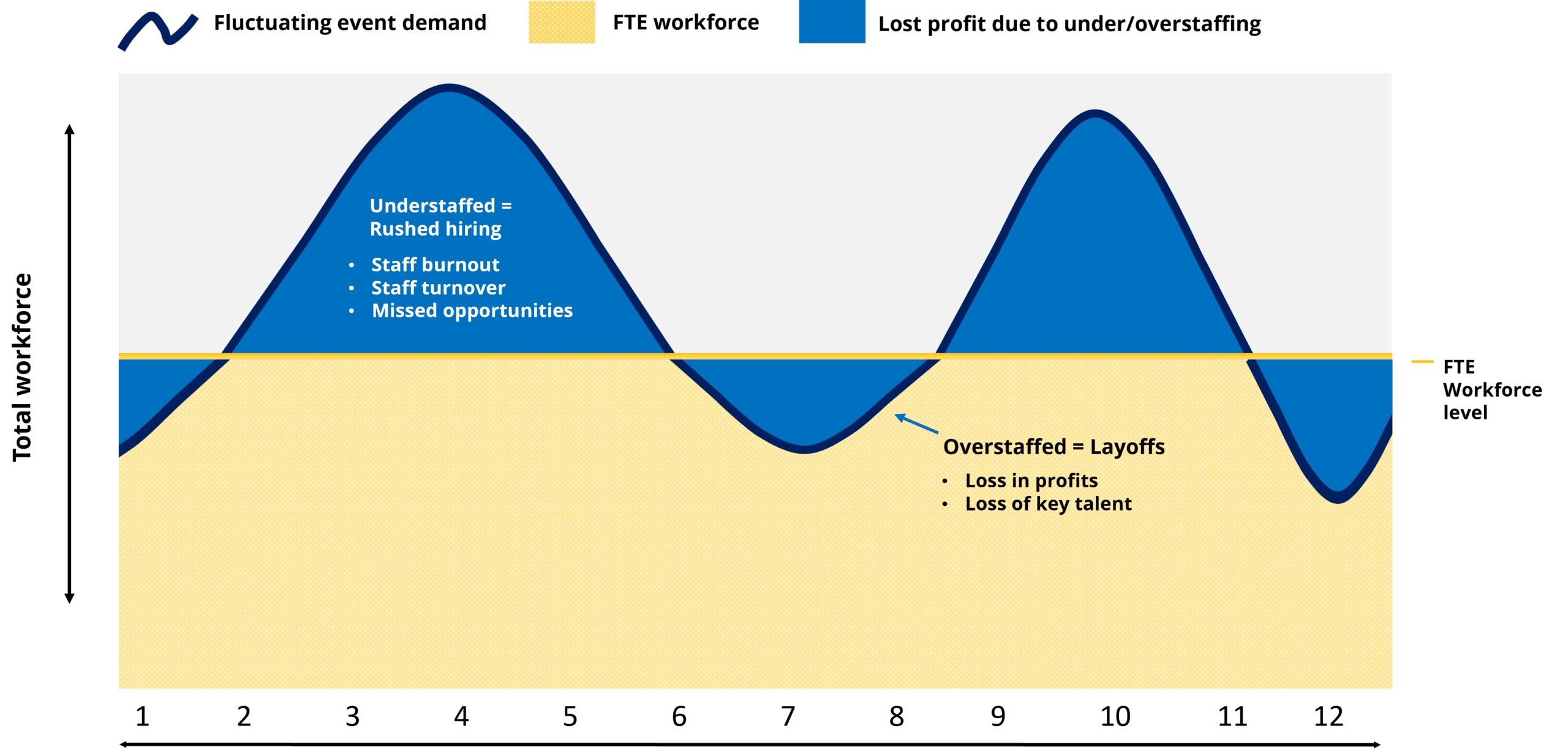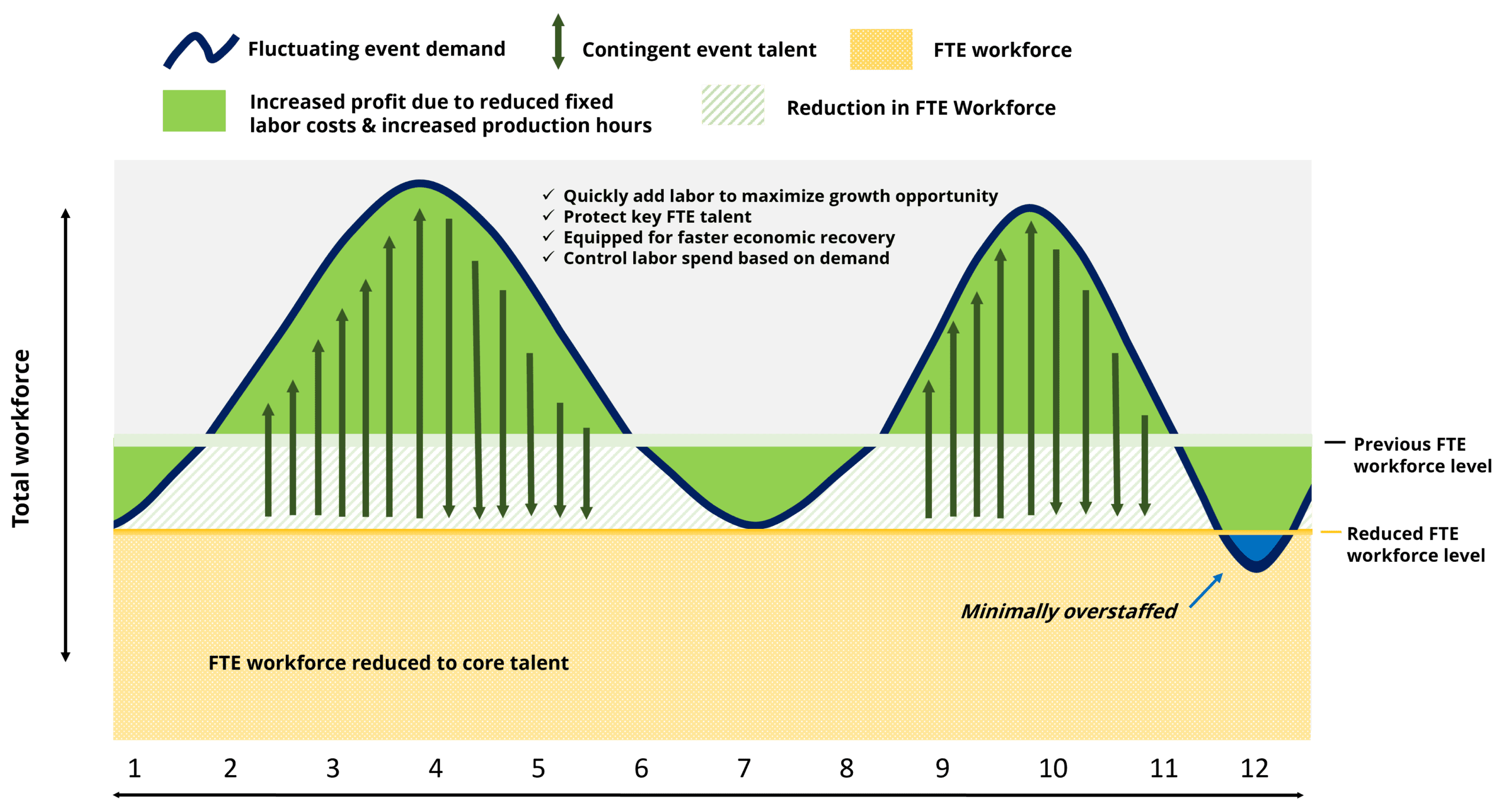Share:
Workforce Agility: Rapidly Adapt to Ever-Changing Market Conditions with Contingent Labor

Agility is now the name of the game, and an agile business needs an agile workforce. In recent years, it’s become increasingly important to be able to swiftly scale output up and down in line with demand. Combine this with the fact that event labor is as scarce and costly as ever, it’s easy to see why a flexible contingent workforce is so critical to the success of any business’s event management goals and bottom line.
Alongside this, there’s a growing recognition that outcome-based statement of work (SOW) projects are transforming how work gets done – meaning that benefiting from the external, non-employee workforce has never been more achievable, or more necessary.
Business agility = Your greatest competitive advantage
In an ever-changing market, a contingent workforce allows businesses to adopt an agile approach. For example, in 2020, COVID-19 forced many businesses to scale back, while others had to significantly transform their activities. As we know, this created a major supply and demand gap leading to massive layoffs across the globe. Fast forward to present day, demand has returned, but many businesses find themselves fighting to fill equally as big of a gap as they now face unprecedented labor shortages. In both cases, organizations with a contingent workforce strategy in place were empowered to close the gap and quickly adapt to meet current demand and competitively navigate the fluctuating market conditions.
The Pandemic is just one data point. Change of almost any nature demands businesses respond flexibly and at speed to remain competitive. Time and again, contingent workers prove to be a professional, efficient, and cost-effective means of delivering agility and offering organizations the ability to take advantage of opportunities before the competition can.
All this to say, whether it be uncertain economic times or industry seasonality, the optimal workforce strategy of choice should include non-employed contingent labor. (See figures 1 and 2)

Agility is now the name of the game, and an agile business needs an agile workforce. In recent years, it’s become increasingly important to be able to swiftly scale output up and down in line with demand. Combine this with the fact that event labor is as scarce and costly as ever, it’s easy to see why a flexible contingent workforce is so critical to the success of any business’s event management goals and bottom line.
Alongside this, there’s a growing recognition that outcome-based statement of work (SOW) projects are transforming how work gets done – meaning that benefiting from the external, non-employee workforce has never been more achievable, or more necessary.
Business agility = Your greatest competitive advantage
In an ever-changing market, a contingent workforce allows businesses to adopt an agile approach. For example, in 2020, COVID-19 forced many businesses to scale back, while others had to significantly transform their activities. As we know, this created a major supply and demand gap leading to massive layoffs across the globe. Fast forward to present day, demand has returned, but many businesses find themselves fighting to fill equally as big of a gap as they now face unprecedented labor shortages. In both cases, organizations with a contingent workforce strategy in place were empowered to close the gap and quickly adapt to meet current demand and competitively navigate the fluctuating market conditions.
The Pandemic is just one data point. Change of almost any nature demands businesses respond flexibly and at speed to remain competitive. Time and again, contingent workers prove to be a professional, efficient, and cost-effective means of delivering agility and offering organizations the ability to take advantage of opportunities before the competition can.
All this to say, whether it be uncertain economic times or industry seasonality, the optimal workforce strategy of choice should include non-employed contingent labor. (See figures 1 and 2)
Figure 1: Traditional workforce responding to demand

Figure 2: Innovative workforce responding to demand

Contingent workforce: A future-proof strategy
At any large organization, a core workforce of thousands will typically be supplemented by a smaller group of contingent personnel. In the Meetings & Events industry, for example, contingent workers will work alongside their permanent counterparts in a variety of roles – from highly skilled Travel Directors to Audio Visual Technicians.
However, sourcing these individuals from different suppliers, and at different rates and terms, creates inconsistencies that lead to spiraling costs and a lack of control and visibility.
By standardizing the process and sourcing contingent workers through one specialized managed service provider, organizations benefit from a trusted, proven partner with access to a wide talent pool – resulting in a zero-waste workforce strategy capable of responding immediately and commercially to a shift if market demand. Additionally, this extends bandwidth and gives internal teams the freedom to focus on client deliverables.
Contingent worker agility: The power of MSPs
Agility involves moving flexibly and swiftly. However, this can be difficult when engaging contingent labor in the traditional manner – either sourcing candidates directly or accessing resources from multiple suppliers with multiple systems, multiple ways of finding labor, and subtly different talent pools.
It can be even more difficult to be agile, effective, and compliant, in the way you engage event suppliers. This is where a managed service provider comes in.
By acting as an intermediary between the buying organization and individual suppliers, a managed service provider like Plannernet can reach out to many more suppliers than an individual organization could by itself. An MSP can also apply consistency and a single set of systems and standards to the sourcing process.
Ultimately, a managed service provider exists to deliver contingent workers at both speed and scale – as well as to build rigorous, consistent engagement processes. They have the expertise to help you build, manage and source from a global talent pool, but also deliver a host of other benefits, including:
• Increased Event Quality & Attendee Experiences
• Compliant Practices
• Lower Talent Costs
• Increased Sustainability
Unlock a workforce that moves when you do
With uncertainty becoming a defining characteristic of our times, business agility will continue to be a competitive differentiator for the foreseeable future, and contingent workers are the most desirable and optimal solution for organizations wanting to achieve this.
Partner with a Contingent Workforce MSP to attract and build relationships with skilled meeting talent; taking the burden of managing contingent labor off your plate, all while strategically integrating and compliantly engaging this workforce to support your organization for the long-term.
As a proven MSP with over 30 years of experience, Plannernet is the largest provider for sourcing top meeting and event freelance professionals around the globe. And while our talent-and-tech-enabled model allows us to deliver the right talent to the right place at the right time, it’s our human-centric approach and value-based service delivery that underscores the relationship with our partners, clients, and suppliers.
To learn more about Plannernet’s managed services and strategic solutions, please contact us today!

